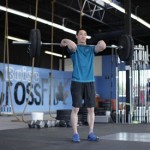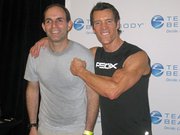A sample text widget
Etiam pulvinar consectetur dolor sed malesuada. Ut convallis
euismod dolor nec pretium. Nunc ut tristique massa.
Nam sodales mi vitae dolor ullamcorper et vulputate enim accumsan.
Morbi orci magna, tincidunt vitae molestie nec, molestie at mi. Nulla nulla lorem,
suscipit in posuere in, interdum non magna.
|
I started my 8 Weeks to SEALFIT journey last spring. The title of the book implies an 8-week program, but in fact that applies to the Advanced Operator Training schedule, and I was not ready for that at the time. I decided to start with the On-Ramp level (4 weeks), then Basic Training (4 weeks), with some recovery weeks in between, and finally, I dipped my toe into Advanced Operator Training. That last one amounts to two full workouts in a single day! What was scheduled for 8 weeks, I split into 2-week increments, so it became more like 12 or 16 weeks. Then, I decided to repeat the schedule, in a modified (easier) way, to improve my technique… And here we are.
How do I feel after all this SEALFIT training? Tired. Also, my lower back is sore. I think the sore back was due to last week’s deadlift session, and although I don’t think it’s serious, it has definitely lasted a few days now. As a result, I scaled back on all my weightlifting this week, rather than increasing my weights. This is similar to how I felt after my first year of P90X. I think I took a good thing and worked on it for too long, with inadequate sleep. Recently I heard that elite athletes sleep 10 to 12 hours per day! My schedule may not allow for that, but I can work on the things that keep me from getting the right amount and quality of sleep.
 (Amazon affiliate link) 
On the plus side, I have achieved certain goals, such as learning to use a barbell, deadlifting my bodyweight, and lifting what I consider to be heavy weights overhead, which I could not do before. I have learned a lot from these Crossfit-style workouts about variety, exercising indoors and outdoors, and using my body for moving in more “natural” ways such as get-ups and bear crawl. I have done more running over these months than I did for years before. Also, those first couple of weeks in Advanced Operator Training, when I at least tried to fit the full schedule into two daily sessions, were a glimpse into the challenges faced by real Navy SEAL candidates.
For the next month or two I am scheduling “recovery” workouts. I will still be breaking a sweat, and lifting lighter weights, challenging myself every day, while making rest and recovery the priority. Maybe when next spring comes, I will go back to the barbell, sandbag, and all the other toys, for a fresh start.
Even while I am taking a break from the exercise portion of the program, I am learning from Mark Divine’s blog and podcast, and reviewing the book. Hopefully I can take some of those lessons into other areas of my life. Hooyah!
I know that there aren’t too many people who follow my blog, and that’s OK, because some posts are very popular (I translate that to “useful” or “interesting”). For those few fortunate souls who have noticed that I haven’t posted anything for a few months, thank you! I hope you’re a member of the Facebook Group, where I post updates almost daily.
I think when I published the latest P90X3 Cast Profile, I in the middle of another round of P90X3. After that, I pulled out the Insanity DVDs for another round (April and May). In June, I started something completely new: 8 Weeks to SEALFIT , a book by Mark Divine. It’s been seven weeks already, and I’ve been learning new exercises inspired by P90X, CrossFit, yoga, and more. (Olympic weightlifting with my new barbell? Yikes!) , a book by Mark Divine. It’s been seven weeks already, and I’ve been learning new exercises inspired by P90X, CrossFit, yoga, and more. (Olympic weightlifting with my new barbell? Yikes!)
I need to pick a time once or twice a week to write blog posts. I want to talk about my experience with SEALFIT, research some more cast profiles, share some great free workout sites, and maybe other topics too. In this season of my life, I’ve been grateful to have the time for the 1-2 hour workouts, and participating in a couple of fitness-related Facebook groups. As I tell people when talking about my workouts, “It’s a hobby.”
I’d love to read your comments here or in the Facebook group about any new workouts you’re doing, or if you have tried any of the ones I have mentioned before. If you’re into SEALFIT or CrossFit, let me know!
There have been Work Capacity sections in every workout since Week 1 of SEALFIT On-Ramp. The focus this week is on Work Capacity as “the ability to do more work in less time” (p. 104). We will be able to do more work by increasing strength and cardiovascular endurance.
 GHD sit up The influence of CrossFit is seen here, with emphasis placed on exercise variety (including location, which means indoors and outdoors), functional movements (no exercise machines or dumbbell curls), and high intensity (including workouts which are timed, to track your performance). Exercises are divided into total body movements, lower body movements, and upper body movements, using the barbell or other methods. New exercises this week: Kettlebell swing, box jump, glute-hamstring developer (GHD) sit ups (on a bench or stability ball).
The schedule was about the same as last week. One day had strength and work capacity sections, the next day had just the work capacity (a rest day for weightlifting), and then back to strength + work capacity. The big news: I did my first named CrossFit workouts! (Did you know CrossFit workouts have names?) I did the “Angie” workout on day 3 of my workout schedule, and “Fight Gone Bad” on day 5 (the end of the week, fortunately). My two main modifications: 1) I don’t do 100 repetitions of anything in one set, as specified in “Angie” for pull ups, push ups, etc. Instead, I did 10 at a time of each, alternating exercises until I got to 100. 2) I didn’t time myself for speed, but I did record the start and end time. Trust me, it felt like I was going fast enough!
Now that I’ve completed the four weeks of On-Ramp training, it’s decision time. Do I continue with Basic Training (listed as an Appendix in the book), or jump into the “8 Weeks” of Advanced Operator Training? I’ll let you know next week…
 Power Clean (bodybuilding.com) The concept of stamina in SEALFIT is not a timed workout (as many Crossfit-style workouts are), and it is not high intensity interval training (HIIT). It is moderate intensity, volume-based training. There are “chipper” sessions, with lots of reps at a moderate intensity, and other sessions which are “rounds for completion” of the exercise circuit. This week, I added several new exercises: Dumbbell push press and thrusters, barbell deadlifts, sumo deadlift-high pull, power clean, wall ball, and dips. I have done deadlifts and thrusters before, but never with a barbell. Eventually, the goal is to deadlift my body weight, or more.
My workouts were 60-90 minutes each day. I stayed on the lower end of the recommended weight for most exercises, to make sure my form was good and I didn’t run out of, you know, stamina… The Work Capacity section could take up to a half hour all by itself, with several rounds of an exercise circuit, including weights. I like adding a 1 mile jog after the workout, before the cool down. The weather is nice, and it helps me to transition from the Work Capacity section.
My average on Grinder PT day is about 1 1/2 circuits in the 20 minute time period. I am working my way to 2 full rounds!
The SEALFIT schedule includes strength training four days per week. Unlike P90X, which is primarily “body split” training (upper body one day, lower body the next, etc.), SEALFIT uses a specific barbell lift as the focus for each day. For example, there are overhead presses, deadlifts, squats, etc.
The overall goal of the program is to increase the body’s durability and the ability to carry heavy loads. For the “On-Ramp” phase, the recommended repetitions are done within a certain weight range. More advanced phases use 10-rep, 5-rep and 1-rep maximum weight as the recommendation. In the introduction to this week’s workouts, Mark Divine emphasizes proper form and risk of injury if the weight chosen is too heavy. For example, his own injuries have occurred while attempting 1-rep maximum weight lifts, so he recommends focusing on 10-rep, 5-rep, or even 3-rep lifts instead.
The workout time this week was 1 1/2 hours per day on average. I used the lower recommended weights, which some might say are for the women, but then again at my age I also fall into the category of a “Masters athlete” so I will take what I can get. It wasn’t easy no matter what you call it!
In general, workouts started with the mobility drill (15 minutes), then body weight/aerobic exercises and maybe some strength training warm up. After that, strength training on certain days (5 reps x 5 sets, with the recommended weight). Then came the Work Capacity section, with anything from lunges to burpees to medicine ball slams to pull ups… Something different every day. At the end was the Durability section, which for now is yoga or shoulder mobility exercises. One day was “Grinder PT” for 20 minutes, including a variety of bodyweight exercises, then a recovery run.
Now it’s getting serious! The barbell lifts take more coordination than I expected, when you have to get the bar off the ground safely, up to your shoulders, and then lift it overhead a certain way. That will take some practice.
|
|




